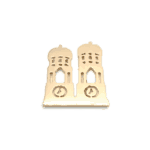Ramersdorf is a district in the south-east of Munich, bordered by Au-Haidhausen, Berg am Laim, Obergiesing and Perlach. The district was first documented in the 11th century. The name comes from the Rumolte family, who lived here around the year 1000 in the so-called ‘Rumoltesdorf’. In the Middle Ages, rich ministerial and patrician families with large estates lived here. From 1818, Ramersdorf was considered an independent municipality and was finally incorporated into Munich in 1864.
One of the most important pilgrimage churches
The Frauenkirche is a symbol of Munich and Maria Ramersdorf as the landmark that can be seen from afar from Ramersdorf.  It is one of the oldest and most important pilgrimage churches in Bavaria. It was first mentioned in documents in the 14th century. Its origins are somewhat obscure. Legend has it that the noble Rumolte family built their own church on the hill, which is still recognisable today.
It is one of the oldest and most important pilgrimage churches in Bavaria. It was first mentioned in documents in the 14th century. Its origins are somewhat obscure. Legend has it that the noble Rumolte family built their own church on the hill, which is still recognisable today.
Maria Ramersdorf only received its onion dome at the end of the 18th century, after the tower was partially destroyed by lightning. The church was only slightly damaged during the Second World War, was repaired immediately after the end of the war and was last extensively renovated between 2014 and 2018. Maria Ramersdorf is considered the third most important place of pilgrimage in Bavaria after Ettal and Altötting, particularly because of its many relics. The altar of the cross inside was designed by the sculptor and master builder Erasmus Grasser.
The old town centre is surrounded by traffic
The historic centre of Ramersdorf is located around the pilgrimage church. Next to Maria Ramersdorf is the old inn, which has been around since the 17th century, as well as the sacristan's house and the electoral hunting lodge. Unfortunately, everything is wedged between major roads, but this is set to change in the future.
Idyll in listed housing estates
Today, Ramersdorf is mainly a residential neighbourhood with over 150 hectares of greenery and beautiful, quiet corners. One exceptionally idyllic part of the neighbourhood is the Ramersdorf model estate, which is somewhat hidden to the west of the pilgrimage church. Around 200 detached houses of various designs were built here in 1934, along with public parks and a church. The entire ensemble is now a listed building, which means that any changes to the houses require special authorisation. While many other neighbourhoods are becoming ever more densely populated, the look and quality of life are being preserved here.
Another historic area worth seeing is around Loehleplatz. The beautifully designed housing estates and terraced houses are still considered a prime example of picturesque urban development today.
Although Ramersdorf is an important transport hub due to its location at the end of the Munich-Salzburg motorway as the ‘gateway to the south’, many Munich residents are not familiar with the district. Not everywhere, but in large parts of the district it is very quiet and green to live here. The local recreation areas of Ostpark and Perlacher Forst also ensure this.